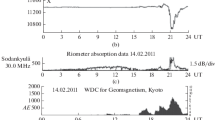Conclusions
Thus, our investigations with 10-μsec resolution have shown that a diffuse signal usually consisted of several discrete pulses among which there is a well-defined peak pulse. The time extent of a diffuse pulse group was 40–80 μsec for vertical sounding and 100–150 μsec for oblique sounding. The most probable shift between adjacent pulses was 15–20 μsec. For oblique sounding, and for vertical sounding at frequencies ω>0.8ωc, individual diffuse-signal pulses fluctuated in amplitude and delay time. For vertical sounding at frequencies ω<0.8ωc, the pulses fluctuated in amplitude and had stable time shifts over a 2-min observation run.
For a vertical sounding, the effect prevailing among the four possible mechanisms considered for generation of diffuse reflections in the plane of the meridian at mid- and low latitudes is scattering by magnetically oriented inhomogeneities, while in the latitude plane it is the partial-reflection mechanism.
The diffuse-signal structure for oblique sounding may be explained satisfactorily by the mechanism of forward scattering by discrete irregularities of a layer. In this case, the scattering and reception angles prove to be related in single-valued fashion to the group delay time for known average layer parameters. This makes it possible to determine the scattering indicatrix of an irregularity and the angular spectrum of the waves.
Similar content being viewed by others
Literature Cited
V. D. Kokourov and N. A. Chernobrovkina, Results of Observation and Research during the International Year of the Quiet Sun [in Russian], No. 3, (1967), p. 58.
Newman (editor), F-Spread and Its Effects upon Radio-Wave Propagation and Communications (1966).
J. Renau, J. Geophys. Res.,64, 971 (1959).
G. A. King, J. Terr. Atm. Phys.,32, 209 (1970).
J. Renau, J. Geophys. Res.,65, 2269, 3219 (1960).
D. S. Bugnolo, J. Geophys. Res.,65, 3925 (1960).
F. N. Hibberd, J. Atm. Terr. Phys.,33, 783 (1971).
V. A. Alimov, L. M. Erukhimov, and T. S. Pyrkova. Geomagn. Aéron.,10 (1972).
S. A. Namazov and T. E. Ryzhkina, in: Abstracts of Reports to the Tenth All-Union Conference on Radio-Wave Propagation [in Russian], Part 1, Izd. Nauka, Moscow (1972), p. 157.
Additional information
Institute of Radio Engineering and Electronics, Academy of Sciences of the USSR. Translated from Izvestiya Vysshikh Uchebnykh Zavedenii, Radiofizika, Vol. 18, No. 9, pp. 1355–1364, September, 1975.
Rights and permissions
About this article
Cite this article
Namazov, S.A. Signal structure in diffuse refraction from the ionosphere. Radiophys Quantum Electron 18, 1002–1009 (1975). https://doi.org/10.1007/BF01038197
Issue Date:
DOI: https://doi.org/10.1007/BF01038197




